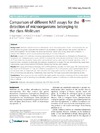Identificador persistente para citar o vincular este elemento:
https://accedacris.ulpgc.es/jspui/handle/10553/35711
| Título: | Comparison of different NAT assays for the detection of microorganisms belonging to the class Mollicutes | Autores/as: | Vega-Orellana, O. Poveda Guerrero, José Bismarck Rosales Santana, Rubén S. Bradbury, J.M. Poveda Turrado, Carlos Guillermo Mederos Iriarte, Lidia Esther Tavío Pérez, María del Mar Ramírez, Ana S. |
Clasificación UNESCO: | 2414 Microbiología | Palabras clave: | Mollicutes Mycoplasma Diagnostic Nat PCR, et al. |
Fecha de publicación: | 2017 | Publicación seriada: | BMC Veterinary Research | Resumen: | Background: Mollicutes detection can be cumbersome due to their slow growth in vitro. For this reason, the use of DNA based on generic molecular tests represents an alternative for rapid, sensitive and specific detection of these microorganism. For this reason, six previously described nucleic acid testing assays were compared to evaluate their ability to detect microorganisms belonging to the class Mollicutes. Methods: A panel of 61 mollicutes, including representatives from the Mycoplasma, Acholeplasma, Mesoplasma, Spiroplasma and Ureaplasma genus, were selected to evaluate the sensitivity and specificity of these assays. A total of 21 non-mollicutes, including closely related non-mollicutes species, were used to evaluate specificity. Limits of detection were calculated to determine the analytical sensitivity of the assays. The two best performing assays were subsequently adapted into real-time PCR format, followed by melting curve analysis. Results: Both assays performed satisfactorily, with a 100\% specificity described for both assays. The detection limits were found to be between 10(-4) and 10(-5) dilutions, equivalent to 15 to 150 genome copies approximately. Based on our work, both van Kuppeveld and Botes real-time PCR assays were found to be the best performing tests in terms of sensitivity and specificity. Furthermore, Botes real-time PCR assay could detect phytoplasmas as well. Conclusions: These assays can be very useful for the rapid, specific and sensitive screening cell line contaminants, clinical samples as well as detecting non-culturable, unknown species of mollicutes or mollicutes whose growth is slow or difficult. | URI: | https://accedacris.ulpgc.es/handle/10553/35711 | ISSN: | 1746-6148 | DOI: | 10.1186/s12917-017-1116-2 | Fuente: | BMC Veterinary Research [ISSN 1746-6148], v. 13, article number 195 |
| Colección: | Artículos |
Citas SCOPUSTM
8
actualizado el 08-jun-2025
Citas de WEB OF SCIENCETM
Citations
8
actualizado el 08-jun-2025
Visitas
164
actualizado el 12-oct-2024
Descargas
141
actualizado el 12-oct-2024
Google ScholarTM
Verifica
Altmetric
Comparte
Exporta metadatos
Los elementos en ULPGC accedaCRIS están protegidos por derechos de autor con todos los derechos reservados, a menos que se indique lo contrario.
